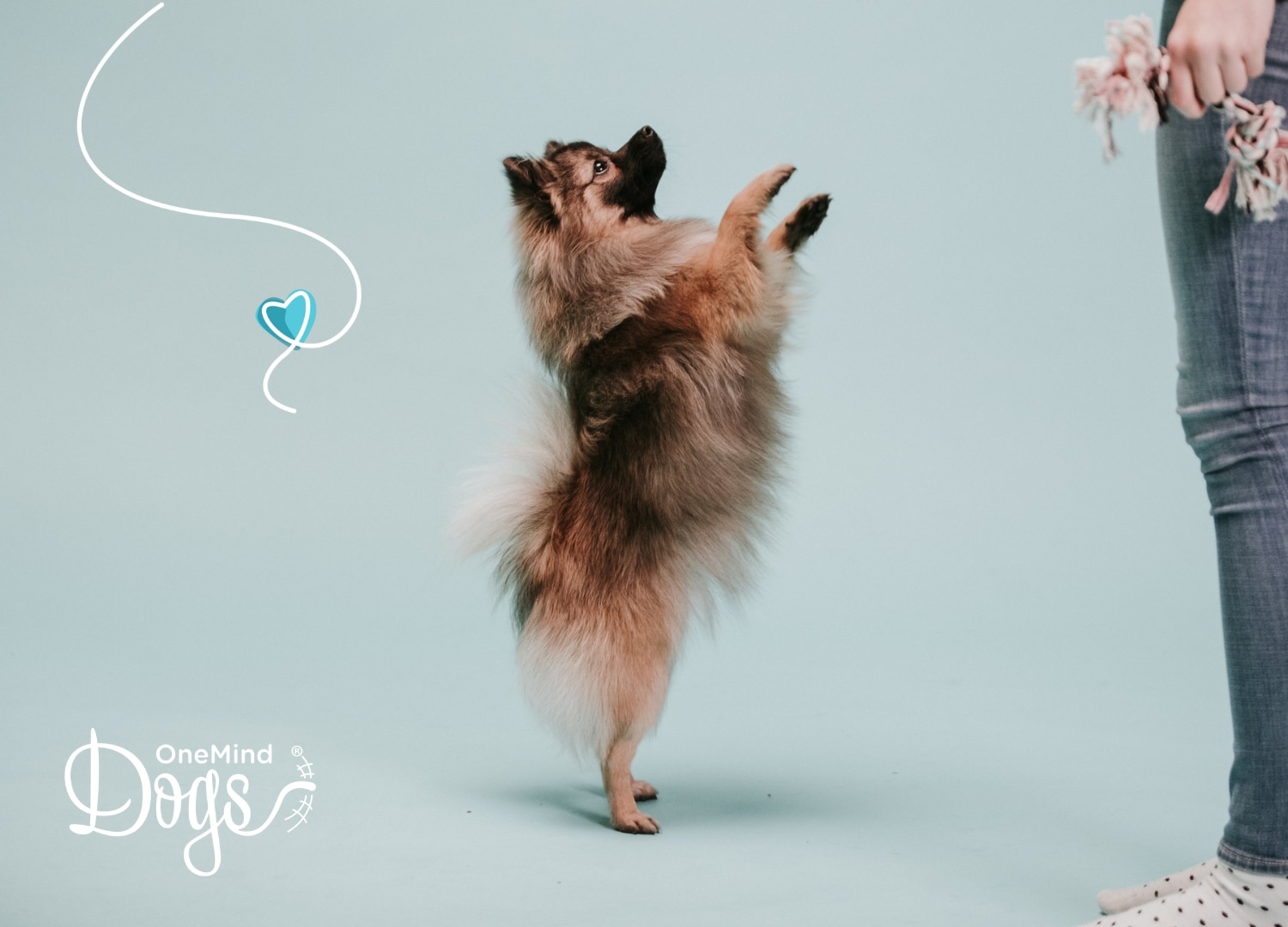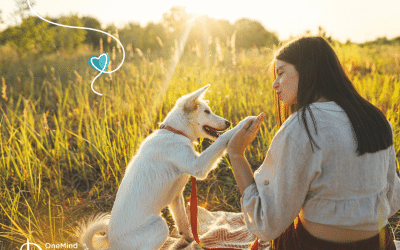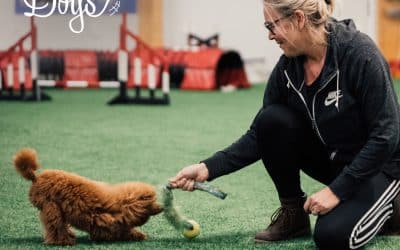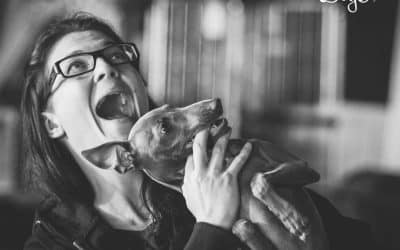We get it, mastering dog and puppy training isn’t always easy! There are so many sources online, in books and in puppy schools that contradict each other. Many of these references provide conflicting advice or are not considerate of the dog’s perspective when it comes to training. We’re here to help you navigate through the information overload by giving you easy-to-follow steps, from your dog’s perspective. For a fun and happy life together with your dog!
Our experts at OneMind Dogs have prepared this guide to help you master everything about dog and puppy training. Read on to discover effective training tips that will strengthen your bond and make your life together fun and exciting!
Understanding the importance of dog and puppy training
Dog and puppy training goes way beyond just having a pet that doesn’t turn your house upside down. It’s about creating a shared language between you and your best friend—a way to communicate that strengthens your bond and makes every day together smoother and more enjoyable.
Imagine bringing a new housemate into your home. You’d want to show them around, teach them where things are, and how to live harmoniously with you, right? The same goes for your new dog or puppy. That’s why our dog training experts created the completely free resource, The Ultimate Puppy Starter Kit. This downloadable package is full of guides, eBooks, infographics, videos and more. It is one reference you don’t want to miss!
Your puppy’s world is an exciting mix of new scents, intriguing flavors, and the joy of discovering what belly rubs feel like. Proper training is their roadmap through this new world. It sets the tone for your puppy’s understanding of their new environment and what you expect from them.
Training will help your dog in the following areas:
- Safety: A well-trained dog knows to stay put instead of darting into the street after a squirrel.
- Social aspect: A trained dog knows how to behave, so you can take them to more places without worrying about unexpected mishaps or antisocial behavior.
- Mutual respect: Effective training helps you and your dog to develop mutual respect for one another, without fear. This respect makes every interaction more positive and reinforces their trust in you.
- Mental stimulation: Training challenges your dog’s brain and body, keeps them engaged, and helps prevent boredom-related behaviors like chewing or excessive barking.
Basic obedience training skills for all dogs and puppies
Most new dog owners focus on teaching the basic obedience commands and leave it at that. Whilst there is a definite value in teaching basic skills like sit and stay, come when called and loose leash walking, dog training is SO much more than that. Your dog will learn these skills (and many others) much more easily if you work on your connection and joy of training together first. Make training a fun experience for you both and you’ll find things become much easier!
Once you have that bond built up, here are some key skills that all dogs should learn:
- Sit: This skill is like the “please” of the dog world. If they want attention, pats or treats, it’s just good manners to sit first and wait patiently. The main reason to teach this skill is to give your dog a behavior to default to that doesn’t involve muddy paws on your favorite shirt.
- Stay: This one’s all about self-control, teaching your dog to hold their ground regardless of distractions. Plus it’s handy when you want to get the mail without being knocked down the steps by your enthusiastic puppy!
- Come: Training your dog to come when he’s called ensures they learn to prioritize your call over any other temptation. Very handy when a pesky bunny decides to dart across your path!
- Heel: Learning to walk on a loose leash on cue makes walking enjoyable and ensures even your elderly grandma can walk your dog without fear of being dragged down the road.
- Watch: Teaching your dog to look at you on command is very useful when distractions are around or when you need your dog to focus on you before giving a different cue.
Crate training and housebreaking
Crate training and housebreaking go hand in hand when it comes to turning your home into a happy, mess-free zone for both you and your puppy. At its core, crate training is about creating a cozy, private space for your puppy where he feels secure enough to relax and stay out of trouble.
When choosing the right crate or pen, ensure it’s big enough for him to walk around, stretch, and snooze without too much extra space. Too much room might tempt him to designate a corner as his personal bathroom, derailing your training efforts .
On the other hand, housebreaking is about teaching your puppy where it’s appropriate to do their business. It’s a consistent routine of taking your puppy outside to potty regularly, especially after meals, playtime, and naps. Make sure you continue rewarding them for toileting in the right place until they are fully toilet trained (and even then, a nice surprise every now and then goes a long way). It’s important to never punish your dog for pottying in the wrong place (this will backfire and lead to hidden poops in hard to find places). Instead, take them out more often and have puppy in a pen if you can’t supervise directly.
Positive reinforcement training techniques
Positive reinforcement focuses on rewarding good behavior instead of punishing the bad, creating a positive association with desired behaviors through rewards. Here’s how it works: When your dog follows a cue or behaves desirably, you immediately reward them. Don’t wait for a mistake, carry around rewards and sporadically reward your puppy when they’re doing something you like.
This could be with treats, praise, petting, or playtime — whatever makes your pup’s tail wag the most. The key is timing; the reward must come right after the desired action, so your dog connects the behavior with the positive outcome. By consistently using positive reinforcement, you’re building a bond based on mutual respect and understanding.
Dealing with common behavior problems
Dealing with problematic dog behavior like chewing, barking, and jumping requires patience, understanding of your dog’s perspective, and a consistent approach. Check out the Puppy Troubleshooting section of our blog for more detailed advice! Here’s some basic tips for tackling these challenges head-on, using strategies that reinforce good behavior without dampening your dog’s spirit:
Chewing
Chewing is a puppy’s way of exploring the world, teething, or simply staying engaged. However, not everything in your home is fair game for a chew toy. The key is to offer appealing alternatives.
Provide a variety of chew toys that are safe and durable, encouraging your pup to use these instead of your furniture or shoes. If they start eyeing something off-limits, redirect their attention with a toy or treat. Should they bite too hard during play, let out a high-pitched “ouch” and pause the interaction, teaching them that gentle play continues the fun, while rough play stops it.
Barking
Barking can be tough to crack, as dogs bark for numerous reasons — alerting, boredom, or even anxiety. However, excessive barking can be disruptive. Identifying the cause is step one.
If it’s attention-seeking or boredom, increasing exercise and mental stimulation is a great start. Teach the “quiet” command by rewarding them when they stop barking on cue. Remember, yelling might sound like you’re joining in, so keep calm and guide gently.
Jumping up
Jumping is often a greeting or a sign of excitement, but it can be unwelcome or dangerous, especially with small children or elderly individuals. Training your dog to sit as a way to greet people teaches them an acceptable alternative to jumping. Ignore your dog when they jump up, and only give attention when all four paws are on the ground.
Advanced training for dogs
Advanced training turns training into an exciting challenge for you and your dog. This level includes dog sports such as agility, teaching tricks, and more complex commands that can keep your dog mentally stimulated and physically fit.
Agility training is like an obstacle course for dogs, enhancing their physical coordination, collection, flexibility, and endurance. Starting with basic foundations at home can spark interest before moving on to more formal training settings.
Teaching tricks like rolling over, playing dead, or even fetching a specific item adds variety to your dog’s routine. Tricks are a fun way to challenge your dog’s mind, keep them engaged, and impress your friends. The key is to break each trick down into small, manageable steps, rewarding your dog for each successful move.
For those looking to push the envelope, exploring activities like scent work, where dogs use their natural sniffing abilities to find specific objects, can be incredibly rewarding. It taps into their innate skills, providing mental stimulation and a sense of purpose.
Training tips for specific breeds and temperaments
Training a dog is not a one-size-fits-all affair. Here’s a quick guide to adapting your training strategy to your dog’s unique personality and breed characteristics:
- High-energy breeds: For breeds like Border Collies and Australian Shepherds, channel their boundless energy into structured activities. Agility training, tricks and long hikes can keep them mentally stimulated and physically satisfied.
- Working breeds: Working breeds such as German Shepherds and Dobermans excel with jobs to do. Training that mimics working tasks, like obedience, rally-o or protection sports can fulfill their need for purpose.
- Independent breeds: These dogs include the primitive dog breeds like the Baenji, and can be more challenging to train. Work out what they like and you’ll have the key to unlock their participation.
- Sensitive breeds: Breeds like Italian Greyhounds respond well to gentle, positive reinforcement. Harsh cues can be counterproductive, leading to shyness or anxiety.
- Small breeds: The likes of Chihuahuas and Pomeranians hugely benefit from appropriate socialization training to teach them that the world is big, but not a scary place. Teach them that other people and dogs are just part of the background and their main focus should be on you.
Training tools and equipment for dog and puppy training
Here’s a quick rundown of the essential gear you need to keep your dog and puppy training sessions productive and fun:
- Safe collar (e.g., flat collar with a quick release buckle ideally)
- Harness (make sure to have it fitted by a professional)
- Leash (standard and long lines, biothane is great)
- Treat pouches (easy access!)
- Your dog’s favorite tug or fetch toy
- High-value treats (soft and easy to swallow)
- Enrichment toys (e.g., puzzle toys, Kongs)
- Safe chew toys
The role of consistency and patience in dog and puppy training
Consistency and patience are the twin pillars of successful dog and puppy training. Being consistent means using the same cues, expectations and consequences every time. This clarity helps your dog understand exactly what you expect, turning desired behaviors into second nature.
Patience is your greatest virtue in this dog training journey. Not every day will be a breakthrough, and that’s okay. Showing patience — celebrating the small victories and not sweating the setbacks — teaches your dog that learning is a safe, positive experience.
Make OneMind Dogs your partner in dog and puppy training
Embarking on the journey of dog and puppy training can sometimes feel overwhelming. If you’re at a crossroads and unsure of where to start, let OneMind Dogs be your guide. Our unique approach is rooted in seeing the world from your dog’s point of view, strengthening your bond, and making training an enjoyable adventure for both of you.
Whether you’re dealing with a playful puppy or an adult dog needing to brush up on their manners, our online program lays out a clear path to success. Dive into our lessons, rich with video content to show you the ropes, then practice at your own pace, building skills that last a lifetime. Start your free trial today and experience the joy of training your dog with confidence and peace of mind.




